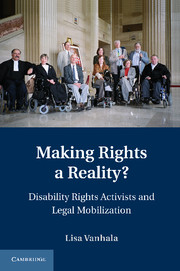Book contents
- Frontmatter
- Contents
- List of Figure and Tables
- Acknowledgments
- Abbreviations
- 1 Introduction: Legal Mobilization and Accommodating Social Movements
- 2 Rights and Political Identity in the Canadian Disability Movement
- 3 Disability Equality and Opportunity in the Supreme Court of Canada
- 4 Disability Organizations and the Diffusion of Rights in the United Kingdom
- 5 Framing Disability Equality in the UK Courts
- 6 Conclusions: Litigation, Mobilization, and Social Movements
- Bibliography
- Index
2 - Rights and Political Identity in the Canadian Disability Movement
Published online by Cambridge University Press: 03 May 2011
- Frontmatter
- Contents
- List of Figure and Tables
- Acknowledgments
- Abbreviations
- 1 Introduction: Legal Mobilization and Accommodating Social Movements
- 2 Rights and Political Identity in the Canadian Disability Movement
- 3 Disability Equality and Opportunity in the Supreme Court of Canada
- 4 Disability Organizations and the Diffusion of Rights in the United Kingdom
- 5 Framing Disability Equality in the UK Courts
- 6 Conclusions: Litigation, Mobilization, and Social Movements
- Bibliography
- Index
Summary
INTRODUCTION
On November 3, 1980, members of the Coalition of Provincial Organizations of the Handicapped (COPOH) held a protest on Parliament Hill in Ottawa to assert their demands for recognition in a proposed new constitutional Charter of Rights and Freedoms. The protest was the first time that people with a range of disabilities gathered together from across Canada to loudly and publicly claim the right to disability rights. The proposed Charter contained a section explicitly guaranteeing equality rights on some grounds, such as sex and race, but did not accord such protection to the rights of Canadians with disabilities. Previous calls by activists with disabilities to gain a voice in the constitutional process had failed, and the activists' frustration culminated in the demonstration. Yvonne Peters, a long-time activist and human rights lawyer who was both present at the protest and active in the Charter lobby effort, writes, “People with disabilities were just beginning to experience the promise of rights, and we were resolved not to let the architects of the Charter diminish or undermine this potential by ignoring our claim to legally recognized equality.” In the end, disability as an enumerated ground was added to the list of grounds protected by the proposed Charter at the eleventh hour in the Constitutional negotiations after a relentless lobbying effort on the part of these activists and their allies. As a result, Canadians with disabilities can now call on the promise of equality contained within the Charter to combat discrimination, exclusion, and marginalization.
- Type
- Chapter
- Information
- Making Rights a Reality?Disability Rights Activists and Legal Mobilization, pp. 48 - 107Publisher: Cambridge University PressPrint publication year: 2010



